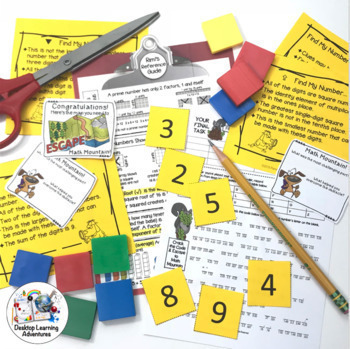Math Escape Room - Decimals, Problem Solving & Crack the Code
- Zip
Description
If you’re looking for a fun way to have kids apply what they’ve learned at the end of the year, look no further! This engaging, team-building math escape room experience, steeped with problem-solving challenges designed to review multi-step equations, fractional parts of a whole number, and order of operations practice is just the ticket!
Whether it’s Back to School or End of Year, before or after holiday breaks, or anytime a review, brain break, or jump start is needed, this escape fits the bill.
Escape to Math Mountain requires kids to apply all their math knowledge as they make their way to the final challenge, a Crack the Code puzzle with a thought-provoking message. It’s a good, quick look into their knowledge of decimals.
This captivating ESCAPE adventure begins when YOU - the most awesome teacher in the history of the world- plan a field trip to Math Mountain. You've given your kids everything they need to make it to the top where you will be patiently waiting. As might be expected, they decide to take a "shortcut" and end up lost on Apex Peak. Not to worry. They meet Rimi, a funny little man who promises to show them the super-secret path that will point them in the right direction... Or, will he...
Your kids will have to use every last ounce of their math smarts to prove they are worthy of his help.
The comic book format sets up this exciting adventure where they complete a series of 4 challenges: puzzles adding & subtracting decimals, a maze with multi-step equations, a series of mystery numbers, and a math trivia challenge.
==========WHAT IS INCLUDED?==========
♦ At-a-glance instructions for EASY setup and organization.
♦ 4 tasks using the following math skills:
• Addition & subtraction of decimals
• Inverse operations
• Multi-step equations with a lot of mental math, exponents, square roots, fractional parts of a whole, percentages, and mean
• Decimal place value up to thousandths
• Ordering decimals
♦ Crack the Code puzzle that pulls it all together.
♦ Two takeaways that are useful well beyond the escape: Rimi's (Math) Reference Guide & Mt. Mike's Wilderness Survival Tips
♦ At-a-glance answers.
♦ Reflective exit slips.
♦ Awards to celebrate a successful escape.
==========WHAT DO I HAVE TO SUPPLY?==========
This Escape offers two identical files, one in color, and the other, in black and white.
All that is needed is a few folders, scissors, and possibly calculators (to be used ONLY as a last resort). Unlike other breakout activities, you don’t have to go out and buy expensive locks and boxes, because everything you need is included. Just print and go!
==========WHAT MAKES THIS SPECIAL?==========
The storyline is interactive and immersive. YOUR students are directly involved in the story. If used as a pre-assessment or review, it will provide you with a perfect opportunity to discern where everyone is in their understanding of these concepts. All of our escapes resources are great to use for teacher observation.
==========HOW LONG DOES IT TAKE?==========
Completing the entire escape will take 50-60 minutes. Students will not have to leave the room. This is NOT a scavenger hunt.
Have fun and be sure to come back for more escape room challenges!
Thanks for stopping by! Pam Kranz
***************************************************************************
© Pamela Kranz Desktop Learning Adventures All Rights Reserved





